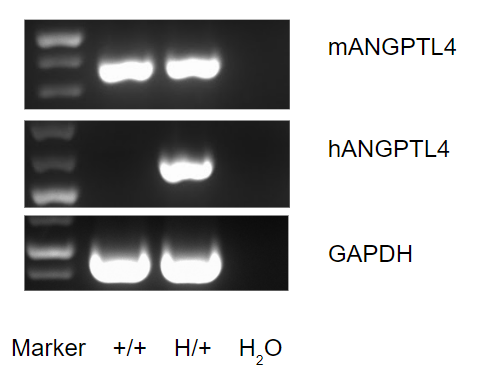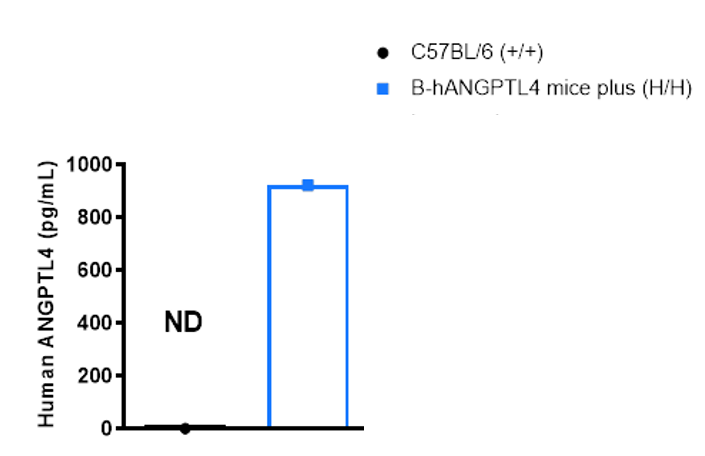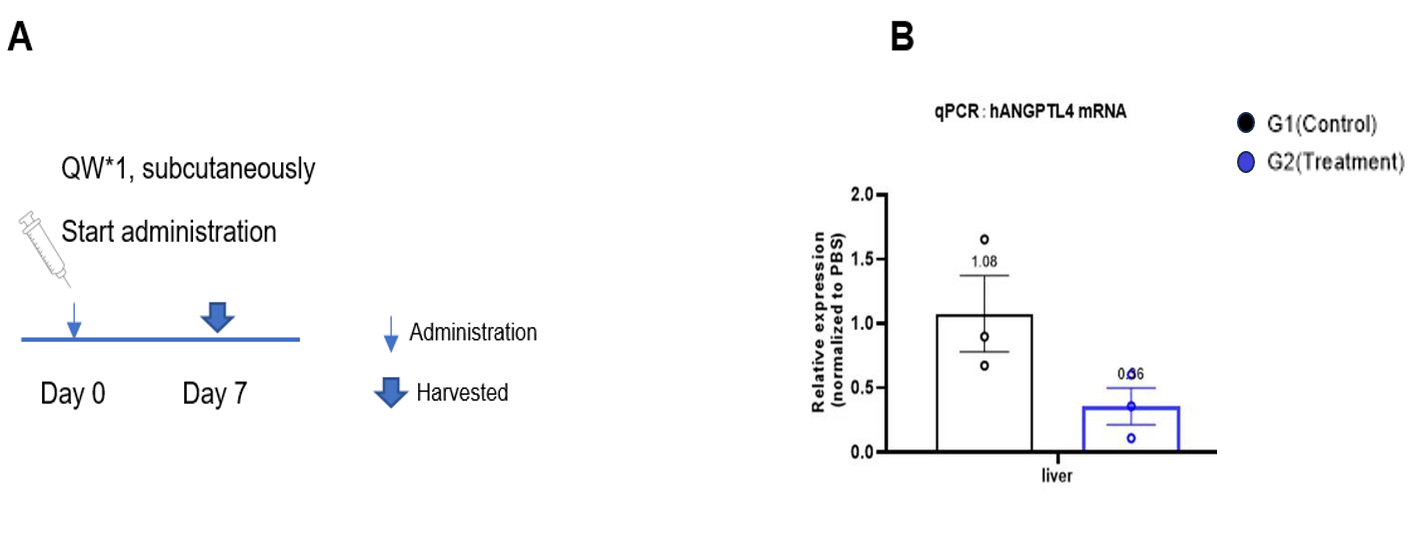Basic Information
-
Targeting strategy

-
Gene targeting strategy for B-hANGPTL4 mice plus.
The genome of mouse Angptl4 gene including 5’UTR and 3’UTR was replaced by human ANGPTL4 genome including 5’UTR and 3’UTR in B-hANGPTL4 mice plus. -
Protein expression analysis

-

Species-specific analysis of ANGPTL4 gene expression in wild-type mice and B-hANGPTL4 mice plus by RT-PCR. Mouse Angptl4 mRNA was detectable in the fat of wild-type mice (+/+). Human ANGPTL4 mRNA was detectable in heterozygous B-hANGPTL4 mice plus but not in wild-type mice.
-
Protein expression analysis in serum

-
 Species-specific ANGPTL4 expression analysis in homozygous humanized B-hANGPTL4 mice plus by ELISA. Serum was collected from homozygous B-hANGPTL4 mice plus (H/H) (n=1). The protein expression level of ANGPTL4 was analyzed by ELISA. Human ANGPTL4 was detectable in homozygous B-hANGPTL4 mice plus (H/H).
Species-specific ANGPTL4 expression analysis in homozygous humanized B-hANGPTL4 mice plus by ELISA. Serum was collected from homozygous B-hANGPTL4 mice plus (H/H) (n=1). The protein expression level of ANGPTL4 was analyzed by ELISA. Human ANGPTL4 was detectable in homozygous B-hANGPTL4 mice plus (H/H). -
Evaluation of the inhibitory efficacy of nucleic acid therapeutics on the expression level of ANGPTL4 mRNA

-
 Evaluation of the inhibitory efficacy of nucleic acid therapeutics on the expression level of ANGPTL4 mRNA. B-hANGPTL4 mice plus were randomly divided into two groups (n=3/group, 8 weeks old). The human ANGPTL4 targeted nucleic acid drugs (Provided by the client) and PBS were administered to the mice individually. The nucleic acid drugs were administered in the form of PBS aqueous solution. The drug dosages for all animals were calculated according to the body weight. The mice were sacrificed on day 7, and the liver tissue was collected to detect the expression level of human ANGPTL4 mRNA by qPCR. (A) The schematic diagram of experimental processing. (B) The expression of human ANGPTL4mRNA in the liver after treatment. The inhibition rate in the treatment group was 66.7% (The data comes from the client). The human ANGPTL4 in the treatment group (G2) was reduced compared to the control group (G1), demonstrating that B-hANGPTL4 mice plus provide a powerful preclinical model for in vivo evaluation of human ANGPTL4 targeted nucleic acid drugs. Values are expressed as mean ± SEM.
Evaluation of the inhibitory efficacy of nucleic acid therapeutics on the expression level of ANGPTL4 mRNA. B-hANGPTL4 mice plus were randomly divided into two groups (n=3/group, 8 weeks old). The human ANGPTL4 targeted nucleic acid drugs (Provided by the client) and PBS were administered to the mice individually. The nucleic acid drugs were administered in the form of PBS aqueous solution. The drug dosages for all animals were calculated according to the body weight. The mice were sacrificed on day 7, and the liver tissue was collected to detect the expression level of human ANGPTL4 mRNA by qPCR. (A) The schematic diagram of experimental processing. (B) The expression of human ANGPTL4mRNA in the liver after treatment. The inhibition rate in the treatment group was 66.7% (The data comes from the client). The human ANGPTL4 in the treatment group (G2) was reduced compared to the control group (G1), demonstrating that B-hANGPTL4 mice plus provide a powerful preclinical model for in vivo evaluation of human ANGPTL4 targeted nucleic acid drugs. Values are expressed as mean ± SEM.


